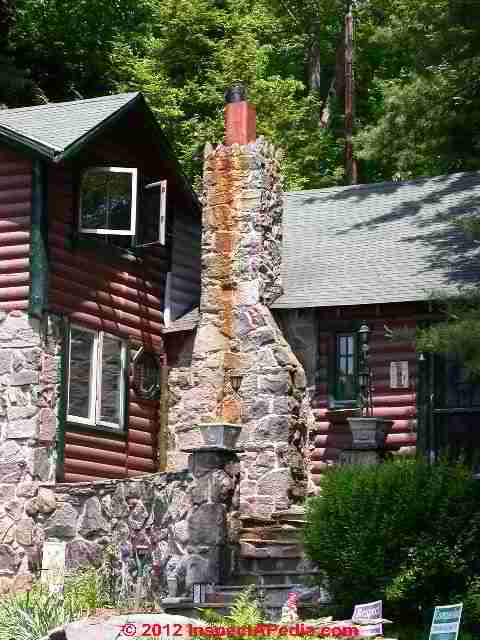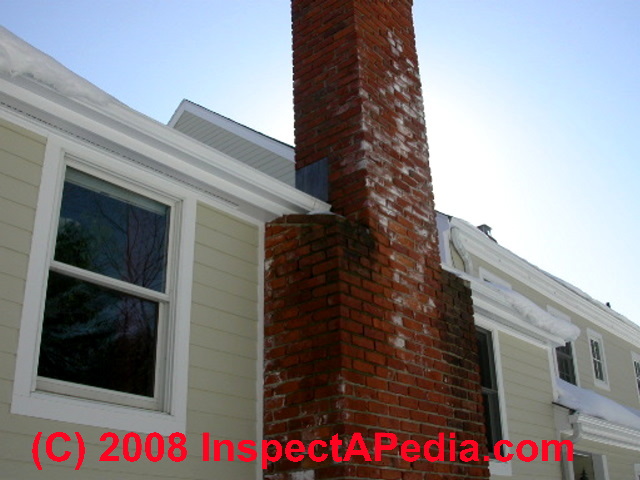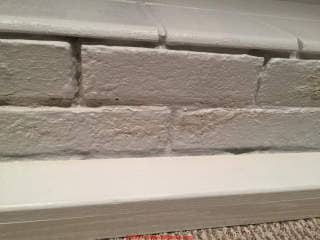 Chimney Stain & Leak FAQs
Chimney Stain & Leak FAQs
Q&A on stains on or near chimney exteriors
- POST a QUESTION or COMMENT about the cause, significance, and cure of stains on chimneys both outside and within buildings
FAQs on how to diagnose & evaluate stains on chimneys outdoors or indoors & where to look for signs of chimney damage.
This article series describes stains that appear on chimney surfaces both indoors and outside. We identify common dark brown or black stains as well as white or light-colored stains or white powdery material that appears on masonry chimney surfaces.
InspectAPedia tolerates no conflicts of interest. We have no relationship with advertisers, products, or services discussed at this website.
- Daniel Friedman, Publisher/Editor/Author - See WHO ARE WE?
FAQs: Stains on a Chimney Exterior Surface: Creosote, soot, water
 These questions & answers about stains found on or at chimneys themselves both on the building exterior, and in the building interior at walls or ceilings near chimneys were posted originally
These questions & answers about stains found on or at chimneys themselves both on the building exterior, and in the building interior at walls or ceilings near chimneys were posted originally
at CHIMNEY STAINS & LEAKS - please be sure to review the advice given there.
[Click to enlarge any image]
On 2019-04-02 by (mod) - unsafe shared chimney or flue
Mary
Shared chimneys might be unsafe and improper regardless of whether or not the chimney liner is replaced after condensation damage - particularly if the chimney is sharing devices on different building floors or levels
It would be smart to get an inspection and advice from a certified chimney sweep.
For example it may be ok to share 2 heating appliances such as a water heater and furnace that are on the same level and go into the chimney at the same point, but it would be improper and unsafe to share a chimney with appliances on different floors in a building.
Furthermore if there has been condensation damage in a flue your expert ought to look at chimney draft, size, venting adequacy since the condensation could be an indication of unsafe conditions - risking fatal carbon monoxide poisoning.
On 2019-03-18 by mary
Do I replace the liner of a shared chimney on the appliance side due to condensation
On 2019-03-04 by (mod) -
You are probably seeing bleed-through of mineral salts from moisture in the brick - effloresence;
You could clean the surface - wire brush, dry it, seal it with a lacquer primer sealer like Bin or Enamelac, then paint with finish coat, BUT if you have an ongoing moisture source the stains will recur.
Search InspectApedia.com for EFFLORESCENCE STAINS to see details.
On 2019-03-04 by Haley
We recently painted our fireplace in our basement. We noticed that an orange color is showing through the paint on the bottom part of the fireplace. What is this and is there a way to fix it? I’ve attached a picture.
On 2018-05-31 by (mod) -
I'm not sure, Mary:
Perhaps the chimney flue has been damaged by frost, leaks, or movement. You could be seeing dust from damaged bricks, flue tile liners, or rust from metal components of a fire place or damper. Or something else - we can only guess.
If you've not done so in the past year you would be smart to have the flue and chimney inspected by a certified chimney sweep.
On 2018-05-30 by Mary
I found a small mound of brick colored powder after using the fireplace. What could be causing this?
On 2018-01-22 by sue
outside of chimney below roof line under eaves makes wet "V" mark and inside attic cinder block part of chimney can seep between blocks with a lot of rain. Had new roof put on and 2 fireplace flues covered with blue stone (dont use them anymore) also had caly pot with cap put on boiler flu. is this a leakage inside the chimney and could the whole chimney be capped with one of those metal vented cap like on the boiler flueto remendy the seepage. cant afford to redo chimney Poor as a church mouse!!
On 2017-10-26 by Chimneyheadache
My chimney leaks at the base of the flue only when we light the fire. I have had the chimney rebuilt with a new lead skirt fitted just above the pitched roof & concrete cap fitted, also fitted a hooded cawl, yet it still leaks & smells of creosote.
On 2017-03-18 by (mod) -
I'd ask a certified chimney sweep to inspect the whole chimney for safety, including creosote build-up and causes of that if it's still present.
If the house smells of creosote I suspect that you're missing a rain cap or there are leaks into the chimney flue and the flue has a bit or maybe an unsafe amount of creosote deposits in the flue.
On 2017-03-17 21:08:54.035236 by Teri
We replaced 1/2 or a little more of our chimney. The older part that may be 15 years old has a blacken color in spots and has a liquid maybe creasote coming out. The house smells. What is wrong?
On 2017-02-27 by (mod) -
That may be just fine - depending on the application (what the brick was used-for) and the brick condition.
On 2017-02-27 by Anonymous
We used aged chimney brick
On 2016-12-12 by Robert wiles
Black spots about 5 feet above ground what is it
On 2015-10-26 by Anonymous
in heavy rain getting water at clean out door
On 2015-06-18 by Anonymous
There are small green spots around my chimmney what are they?
Question: creosote stain diagnosis on chimneys
(Oct 8, 2012) sally bailey said:
I turned my gas heater on yesterday, today I noticed that the outside of the cinderblock chimney was very dark black, I think it best not to use the heater until I have it looked at. How dangerous is this? It seems to be less dark since I turned the heat off.
Mar 11, 2013) charlie said:
my chimney has oozing big time black brown stains obn the outside of the surface, I do have cap on it tha is correct for my chimney, could water realy be leaking in thru the bricks from the inside of the chimney, i look inside from the top it looks to be pretty tight, I have a gase hot air furnace could there be any saftey problems from this leak?
thank you
charlie
Reply:
Charlie,
I suspect condensate is dissolving creosote. Was this chim previously venting an oil burner, coal, or wood fire?
Air and water leaks along a flue could interfere with safe draft, and I speculate that crud dripping bCk into a heating appliance could damage it. Why not schedule a thorough chimney inspection, cleaning, repairs.
Question:
(Mar 21, 2013) Kristen said:
We had horrible dark brown (almost molasses looking) gunk oozing out of our chimney when running our furnace this winter.
The goo, in turn, leaked into the walls and floor around the chimney area. We have since replaced the furnace (it no longer vents through the chimney), and put in a new metal liner for the hot water heater.
Is it safe to replace the walls and floor surrounding this chimney? We have gotten conflicting responses from the HVAC professionals that installed our furnace and chimney liner. One said that the problem is resolved, the other said that the condensation that collected in the chimney will continue to leak into our walls/floor unless we replace the entire chimney. I'd hate to spend the money on replacing the chimney if we don't have to..
Reply:
Kristen,
The goo you describe is usually creosote dissolving and leaking out through defects in the chimney.
You have re-lined the chimney, which, properly performed, should have stopped leaks and made it safe to use. If however there continues to be outdoor water leakage into the chimney structure or condensation forming between the chimney liner and the older chimney materials you may see new oozing and stains emitted.
I'm not sure, however that you have to replace the entire chimney to fix the problem. YOu haven't said how it is constructed; I'm guessing it's masonry - stone, block, brick.
If there are no leaks into the chimney from outside through its walls or top, and if the installer insulated between the chimney liner and original chimney walls, I'd not expect to see much leakage or staining in the future.
Question: how to get rid of chimney stains
(Mar 11, 2014) tillie said:
Have a question. We had a new chimney built 1 year ago (block with clay insulating). We primarily heat with a wood boiler system (a gassification system).
We are starting to notice some black staining outside on the chimney block. We have our chimney and wood boiler professionally cleaned and inspected each year before winter and have not had a problem. What could be causing this, how can we stop it, and how can we get rid of the ugly stains?
Reply:
Black stains on the outside of the masonry block chimney are often caused by leaks out of the internal flue that run down the space between the clay flue tiles and the interior of the masonry blocks, finding an opening in the blocks where the stain seeps out; creosote (from burning wood) combines with condensate moisture to make the actual leaks, but the concerns are more than just the stain;
the question is whether or not the chimney was properly constructed, lined, and leakproof; leaks in the chimney can cause poor draft and can also be a source of a building fire if sparks pass through an opening to contact wood framing; and of course flue gases could also seep into a building.
Sounds as if you need a chimney flue inspection by a certified chimney sweep - someone independent from the builder.
Just "getting rid of the stains" (clean and re-paint with sealer then finish coating on the chimney exterior) are missing the more important concerns.
Question: red roof stains traced to bricks?
(Oct 20, 2014) Anonymous said:
Can reddish roof stains be caused by old chimney bricks?
Reply:
Possibly; follow the stains up-roof: they'll point to the source. Most often I find rusting flashing or other metal on-roof components as the source of red roof stains.
Question:
(Oct 22, 2014) Kayla said:
I have a Columbia summer winter hook up oil boiler. I also have really ugly red staining on the exterior of the stucco chimney.
From the stain pattern, it is clearly coming from the furnace/boiler flue, not the fireplace flue. I've had the chimney cap examined, the chimney swept by a certified chimney sweep, verified the stainless steel lining is fine and is the correct size for the boiler, had the boiler inspected and cleaned by the oil company, and no one can figure out the problem.
There is nothing that is rusting. I've found a few references to the red dye in the oil causing this kind of problem, but not much info and no ideas on how to alleviate the problem.
The chimney stucco itself is not in good shape so I'm arranging to have that fixed, but before I put all that money into it, I'd like to figure out how to avoid the nice new stucco getting stained with red streaks. Help!
Reply:
Red dye in heating oil won't cause red roof stains; more likely someone has missed a combustion issue, chimney contaminant, or a rusting on-roof component.
...
Continue reading at CHIMNEY STAINS & LEAKS - topic home, or select a topic from the closely-related articles below, or see the complete ARTICLE INDEX.
Or see these
Chimney Leak Articles
- CATALOG of ALL ROOF STAINS for the causes and types of stains that occur on building roofs.
- CAUSES of ROOF STAINS
- CHIMNEY CAP & CROWN DEFINITIONS the difference between a chimney rain cap and a chimney top seal - two different possible leak problems.
- CHIMNEY CHASE CONSTRUCTION
- CHIMNEY CLEANOUT DOOR
- CHIMNEY DAMAGE by LEAKS & FROST
- CHIMNEY INSPECTION DIAGNOSIS REPAIR - home
- CHIMNEY INSPECTION from GROUND
- CHIMNEY INSPECTION at ROOFTOP
- CHIMNEY RAIN CAP / RAIN COVER INSPECTION
- CHIMNEY SHOULDER LEAKS
- CHIMNEY STAINS, INDOORS
- CHIMNEY STAINS & LEAKS
- CHIMNEY WET TIME & CORROSION - effects of moisture on metal chimneys & flues
- CRACKED CHIMNEYS, MASONRY BLOCK
- CREOSOTE HAZARDS
- CREOSOTE ODOR CURE / REMOVAL
- DRIPPING WATER SOUND SOURCES
- EFFLORESCENCE REMOVAL & PREVENTION
- EFFLORESCENCE: WHITE DEPOSITS on ROOFS
- FLASHING, CHIMNEY MISTAKES & LEAKS
- MASONRY CLEANERS
- RUST STAINS on ROOFS Rust and red stains on roofs and chimneys
- STAINS on BRICK SURFACES
Suggested citation for this web page
CHIMNEY STAINS & LEAKS FAQs at InspectApedia.com - online encyclopedia of building & environmental inspection, testing, diagnosis, repair, & problem prevention advice.
Or see this
INDEX to RELATED ARTICLES: ARTICLE INDEX to CHIMNEYS & FLUES
Or use the SEARCH BOX found below to Ask a Question or Search InspectApedia
Ask a Question or Search InspectApedia
Try the search box just below, or if you prefer, post a question or comment in the Comments box below and we will respond promptly.
Search the InspectApedia website
Note: appearance of your Comment below may be delayed: if your comment contains an image, photograph, web link, or text that looks to the software as if it might be a web link, your posting will appear after it has been approved by a moderator. Apologies for the delay.
Only one image can be added per comment but you can post as many comments, and therefore images, as you like.
You will not receive a notification when a response to your question has been posted.
Please bookmark this page to make it easy for you to check back for our response.
IF above you see "Comment Form is loading comments..." then COMMENT BOX - countable.ca / bawkbox.com IS NOT WORKING.
In any case you are welcome to send an email directly to us at InspectApedia.com at editor@inspectApedia.com
We'll reply to you directly. Please help us help you by noting, in your email, the URL of the InspectApedia page where you wanted to comment.
Citations & References
In addition to any citations in the article above, a full list is available on request.
- In addition to citations & references found in this article, see the research citations given at the end of the related articles found at our suggested
CONTINUE READING or RECOMMENDED ARTICLES.
- Carson, Dunlop & Associates Ltd., 120 Carlton Street Suite 407, Toronto ON M5A 4K2. Tel: (416) 964-9415 1-800-268-7070 Email: info@carsondunlop.com. Alan Carson is a past president of ASHI, the American Society of Home Inspectors.
Thanks to Alan Carson and Bob Dunlop, for permission for InspectAPedia to use text excerpts from The HOME REFERENCE BOOK - the Encyclopedia of Homes and to use illustrations from The ILLUSTRATED HOME .
Carson Dunlop Associates provides extensive home inspection education and report writing material. In gratitude we provide links to tsome Carson Dunlop Associates products and services.


